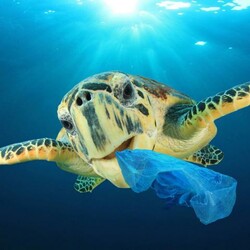Draper’s System to Measure Microplastics in the Ocean with Inaugural Gift from the Wallace Research Foundation
CAMBRIDGE, MA—Microplastics the size of plankton are suspected to be entering the ocean’s food web at an alarming rate, and this plastic smog may be distributed throughout the world’s oceans. Draper and the U.S. Environmental Protection Agency (“EPA” Southwest Region, headquartered in San Francisco) have begun development of a sensing system that will enable a “microplastic weather forecast” with plastic smog density and movement, and will for the first time provide large-scale baseline measurements and track changes over time. The inaugural step in this ambitious work has been enabled by the Wallace Research Foundation in summer 2018.
“We are focusing on microplastics that are the same size as plankton—particles ranging in size from one micron to one millimeter” said Sheila Hemami, Director of Strategic Technical Opportunities at Draper. “Microplastics in the water column have broad-ranging impacts on food security, the global carbon cycle and our planet’s health, and can provide a snapshot of the success of on-shore solid-waste management efforts. This project will ultimately provide a de facto world standard for measurement and assessment, which are required first steps for management and mitigation. We hope that others will see value in this project and will join with the Wallace Research Foundation in supporting this important work. Understanding where the problems are most grave will allow management and mitigation activities worldwide to be directed in the most efficient way possible.”
The Wallace Research Foundation gift provides Draper with an opportunity to assess prototype sensors in the Atlantic (the U.S. Northeast). Draper will support EPA’s San Francisco office in its investigations in areas of the Pacific Ocean as well. This initial testing is designed to provide data needed for a prospective first-generation sensing system. The project will also create a platform for the data that will provide real-time information that will be integrated into a Plastic Particle Pollution Index, according to Hemami. “The Plastic Particle Pollution Index project will enable governments, environmental organizations, NGOs, private entities and individuals worldwide to assess the microplastics level in their ocean and fresh water bodies, thereby providing distributed yet accurate and calibrated measurements,” Hemami said. Information about the program will be available at PPPIndex.info.
The initiative emerges at an important moment for the world’s oceans, according to the Natural Resources Defense Council, which offered the following statement:
“Marine scientists are becoming more and more concerned about how microplastics can harm our oceans. The endangered whale shark and various marine mammals, among other filter feeders, are at risk, according to recent research. This kind of microplastics sensor would be a major step forward in allowing us to document and monitor the problem. In recent decades, the development of automated sensors has transformed the way marine sciences can inform, motivate, and identify solutions to vexing problems in ocean conservation. The development of a microplastic sensor could dramatically accelerate the science and policy around the problem of microplastics in the marine environment. With global plastic production increasing nearly exponentially, we need this kind of innovation now.”
The microplastics project is part of a Draper initiative called Engineering Impact that applies Draper’s capabilities and technologies to global challenges. Other Engineering Impact projects include a pediatric heart valve for infants, maternal ultrasound solutions for ultra-low resource environments, and mobility tools for congested urban environments. Engineering Impact projects are all undertaken with partners who bring invaluable field experience, and are enabled by individuals, foundations, and philanthropists who share Draper’s commitment to positively impacting the future. Those interested in supporting this project can contact Draper at microplastics@draper.com.
Released August 2, 2018

